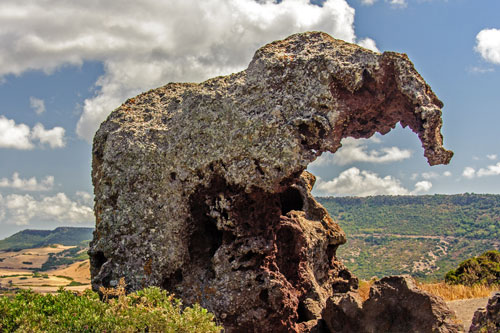Castelsardo and surroundings
map of Castelsardo and surroundings
Castelsardo
 The coastal town of Castelsardo is situated on a rocky peninsula.
The coastal town of Castelsardo is situated on a rocky peninsula.
At its highest point, the noble Genoese family of Doria founded the settlement “Castel Genovese” in 1102.
The castle was constructed, and the settlement was surrounded by high defensive walls. From here, the Genoese controlled maritime trade along the coast.
In 1448, the Spanish conquered the coastal fortress and soon changed its name to “Castello Aragonese.”
The Spanish also made the town an episcopal see and further fortified the defenses.
Sardinia passed to the House of Savoy in 1718. Under Carlo Emanuele III, “Castelsardo” received its present name.

The fortress is open for visitors and now houses the “Museum of Mediterranean Basketry.”
On display are baskets, fish traps, reed boats, and numerous everyday items from all over Sardinia, all crafted from local plants such as dwarf palm, reed, or seagrass.
Both from the castle and various viewpoints in the old town, you can enjoy magnificent views of the coast – on clear days, even as far as Corsica.
The labyrinthine, historic old town also beckons exploration.
It is closed to automobile traffic, so it’s best to park in the more modern part of Castelsardo below. Caution! Many parking spaces here are subject to fees.

Just below the castle, on a rocky promontory facing the sea, stands the “Cattedrale di Sant’Antonio Abate.”
The church was built from basalt stones, giving it a somewhat gloomy appearance.
Its most distinctive feature is the bell tower with its colorful tiled roof. From the church square, there is a magnificent view of the sea.
When the Spanish designated Castel Aragonese as an episcopal see, the old Romanesque church was converted into a cathedral.
Thus, elements of Romanesque, Gothic, and Baroque architecture now characterize the church.
 The interior consists of a barrel vault and a Gothic transept.
The interior consists of a barrel vault and a Gothic transept.
The side altars and the pulpit are carved from wood and adorned with gold.
Several precious paintings embellish the church, with the most valuable being the altarpiece “Madonna with Child and Angels.” This painting is attributed to an unknown master from the 15th century, referred to only as the “Maestro di Castelsardo.”
Additional works by the artist are housed in the cathedral’s crypt.

The old town of Castelsardo (centro storico) nestles beneath the castle on the rocky slopes, with its pretty houses and narrow streets.
Exploring is definitely worth it, but in summer, the many stairs can make it a sweaty affair.
In front of many houses, women sit weaving various basketry items, which they offer for sale.
Most of them belong to a cooperative, whose products are now sold in souvenir shops throughout Sardinia.
Nuraghe Paddagiu
 Just outside of Castelsardo, along the road to Valledoria, atop a hill, stands the remains of the Nuraghe Paddagiu.
Just outside of Castelsardo, along the road to Valledoria, atop a hill, stands the remains of the Nuraghe Paddagiu.
Constructed from dark trachyte blocks, even though the upper part is missing, you can still discern the classic architecture of these towers.
Inside, it is pitch-dark and cramped.
Roccia dell’ Elefante
 The “Elephant” of Castelsardo is surely one of the most popular photo opportunities in Sardinia.
The “Elephant” of Castelsardo is surely one of the most popular photo opportunities in Sardinia.
This peculiarly weathered trachyte rock stands directly next to the SS 134 road towards Sedini. (see map)
Its distinctive shape, however, is only apparent when approaching from the direction of Castelsardo – the backside looks entirely different.
Carved into the rock are rock-cut tombs (domus de janas), some of which are adorned with reliefs.
Terme di Casteldoria

In the hinterland of Valledoria lies a small green oasis along the Fiume Coghinas.
Eucalyptus trees, palms, and shrubs provide shade, and the river forms a small lake inviting for swimming.
Here, several hot springs flow into the Coghinas, warming the river and providing bathing temperatures even in cooler seasons.
It’s a huge delight for children to splash around in the warm water and frolic in the mud.
A spa hotel has also been built by the lake, which resumed operations a few years ago after a long period of closure.
